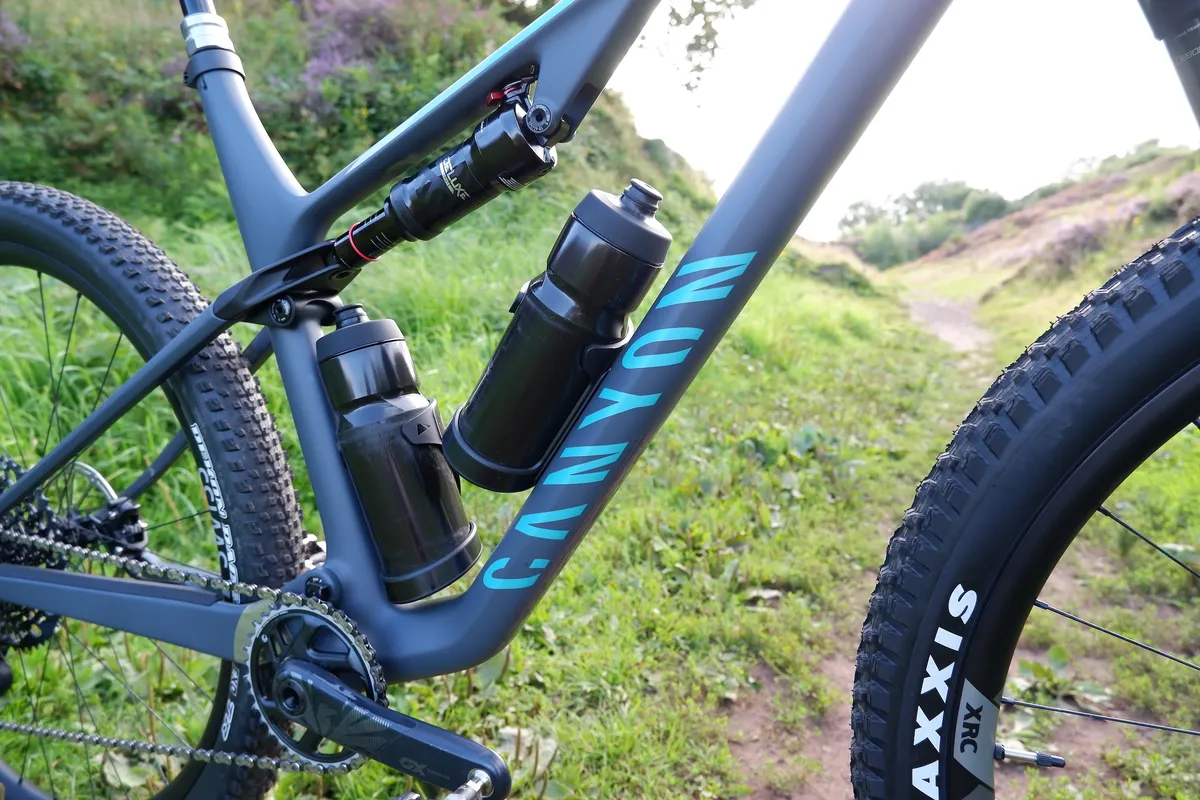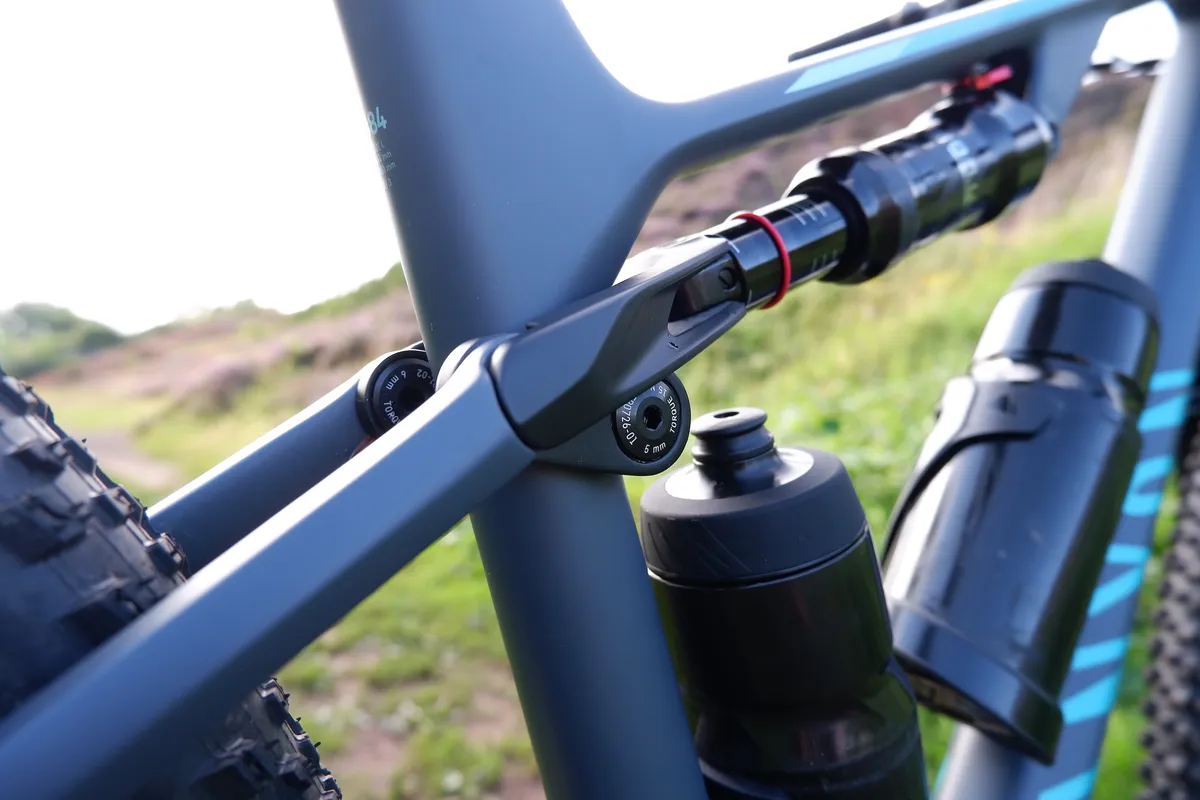Canyon's latest bike, the Lux Trail, joins the ever-growing ranks of downcountry bikes that sit at the crossroads of cross-country, trail and all-mountain. These bikes are often either slimmed-down versions of trail bikes or bulked up XC bikes, as is the case here.
The Lux was arguably getting a little long in the tooth, so an update was not unexpected, however, to see it as a downcountry bike perhaps was.
Canyon says the Lux Trail has been designed for riders looking for a fast bike that can handle a mix of trails or racers looking for more confidence and comfort at long marathon-style XC events.
This aggressive XC bike gets descent-friendly geometry, 110mm of rear-wheel travel, a 120mm RockShox SID fork and more capable components.

Canyon Lux Trail CF 8 frame
As the CF in the name suggests, carbon is used throughout the front and rear triangles. As ever, with Canyon, its industrial designers have been working overtime to help create a beautifully constructed and cleanly finished bike.
It's a distinctly 'Canyon' looking bike, with lines that flow from front to rear, mimicking design DNA found throughout its mountain bike range.
This extends to the braced seat tube, boxy head tube that leads to a down tube with a distinctive belly, and the svelte rocker that drives the shock.
Like many downcountry bikes, the Lux has a single main pivot, flexible seatstays and a shock driven by a rocker. The rear triangle is asymmetric.

The frame has space for a pair of 750mm bottles inside it (well, my size large certainly does), while finishing details – such as the small chainguide, protection from chainslap and chainsuck, and access to the bulk of the pivots from the non-driveside – show plenty of care and attention to detail.
The top of the headset assembly has little wings, which meet a small block on top of the top tube to prevent the bar spinning in a crash, which could damage the frame.

Canyon Lux Trail CF 8 geometry
Key geometry figures for a size large bike:
- Reach: 480mm
- Seat tube: 505mm
- Head angle: 67.5 degrees
- Seat angle: 74.5 degrees
- Effective top tube: 650mm
- Stack: 614mm
- Bottom bracket drop: 38mm
- Chainstay length: 435mm
- Wheelbase: 1,201mm
Canyon Lux Trail CF 6 specification
RockShox' new SID fork is pretty much synonymous with the term downcountry. While XC racers will still appreciate the 32mm stanchion SID SL, the regular SID now comes with a sturdy 35mm chassis that's ideal when pushing a lightweight bike past what previously might have been wise.
This version of the bike gets the Select+ version of the SID, with a Charger 2 RL damper.

At the back, though, Canyon specs the Deluxe rather than SIDLuxe shock, which we often see paired with the SID fork.
Both fork and shock have a lockout, controlled via an on-bar TwistLoc. It's a tidier solution, especially when it comes to handlebar real-estate than a lever-based remote lockout, but I've found you have to twist the twist-grip a fair bit to actuate the lockout.
Access to the shock's rebound adjuster, located between the shock and top tube, is a little fiddly, though.

I'm a fan of SRAM's GX AXS wireless shifting and seeing its latest groupset on this bike is no bad thing.
Shifting is light, reliable and quick, and charging it isn't a chore. A carbon GX crank holds a 34t ring, but to compensate for a slightly bigger ring than a trail bike might get, there's a 10-52t cassette for a nice and low gear at the bottom end.
A Reverb AXS dropper post finishes the electronic package and, again, is something I'm more than happy to see on a test bike.

Canyon has gone to DT Swiss for the wheels, with a pair of carbon XRC 1501 hoops. These have a broad rim bed, providing the Maxxis Rekon (f) and Rekon Race (r) tyres with plenty of support for their 2.4in and 2.3in widths respectively.
Bringing the bike to a stop is a set of SRAM Level TLM brakes with 180/160mm rotors.
The cockpit is all supplied by RaceFace, with its alloy Ride 35 kit performing the duties.

Canyon Lux Trail CF 8 first ride impressions
With just a limited amount of time, I took the Lux Trail to my local XC and downcountry test loops for a quick smash around trails I know like the back of my hand – the ideal way to form some quick impressions of a bike.
As I found recently with the Lux, Canyon's XC-focused suspension is very direct and efficient. There's a fairly dramatic turn of speed when you push on the cranks, thanks to both the linkage's stability under power and the Rekon Race rear tyre limiting rolling resistance nicely.
This means on the flat or up smooth climbs there's little need to twist the lockout. When really pummelling the pedals on tarmac it's possible to get the rear suspension bobbing but, for the most part, I was pretty happy leaving the shock fully open.

Compared to the Lux, with its SIDLuxe shock, I'd say the Deluxe on the Lux Trail is a touch more supple, so while performance under the pedals is similar, there's a little more give than there might have been with the smaller shock fitted.
This aids climbing performance on more marginal surfaces, where I reckon there might be a hint of extra traction on offer.

When it comes to slightly more chunky climbs, the stiff performance of the rear suspension means the bike lurches a little more than some other downcountry bikes as the rear wheel crests up and over steps. While it feels very efficient, other bikes perhaps do a better job of smoothing out technical climbs.
When it comes to the smooth, swooping trails that my test loops take in, the Lux Trail feels good. I like the Rekon tyre, unless it's muddy, because it rolls well and has enough of a shoulder to dig in to trail centre surfaces, delivering good corner speed.
With the back end keeping pedalling efficiency high, jabs at the pedals result in brisk acceleration, and when sat pedalling, speed is easily built.
From initial impressions, there are better bikes out there when it comes to pedalling over the rough – say you want to maintain speed or accelerate over small- to mid-sized rocks on flat trails – such as the Santa Cruz Blur (review coming soon). The suspension doesn't feel as smooth when under pedalling loads to totally isolate you here.

Descents are where downcountry bikes can really make their mark. Some bikes thrive here, throwing away their XC cloaks and revealing themselves to be mini trail bikes.
I'd like to spend more time on the Lux Trail to see if I can really get to the heart of its descending capability, but on initial impressions, it might need a little bit of work to compete with the best descending downcountry bikes.
This may include adjusting fork pressures and tweaking volume spacers to get an improved balance between front and rear suspension. I'd also like to adjust the front end height, perhaps via a new stem, to get the set-up perfect for my preferences.
The headline figures look good – the reach is long and the head angle is where one would expect for such a bike. The stack height is fairly high, though, and the top cap of the headset adds height too. So I've found it a touch taller at the front than I like.
Combined with a super-long 505mm seat tube (460mm wouldn't be considered short these days!), I felt a little more perched on top of the bike. A shorter seat tube would allow for a longer drop dropper, and with a lower front end I think one would feel much more 'in' the bike than 'on' it.

Despite this, the Lux Trail's descending performance is a definite step up from its truly Lycra-clad sibling. The extra travel at the front, along with the slacker head angle, gives you much more breathing space over rocks and roots, and the Deluxe shock at the back further improves rear-end performance.
The Lux Trail also feels like it has a little more mid-stroke support than its XC counterpart. Instead of collapsing into the depths of its mid-stroke, the Lux Trail seems to ease itself into it in a more controlled manner, so you're better able to navigate repeated impacts.
Potentially, this could be due to the suspension's kinematic or a relatively larger negative air spring inside the Deluxe shock than the SIDLuxe on the regular Lux.
As I've said a few times, there's a lot more to explore with the Lux Trail; more trails to ride, more adjustments of pressures and damping levels, and perhaps a couple of small component swaps to see what really makes the bike tick.
Downcountry bikes come from one of two camps: they either provide an extra bit of grunt to their XC DNA or give a trail platform more get-up-and-go. For now, I reckon the Lux Trail sits firmly in the former's camp.
Product
| Brand | Canyon |
| Price | €5499.00, £5399.00 |
Features
| Fork | RockShox SID Select+ |
| Stem | RaceFace Ride 35 |
| Chain | SRAM GX Eagle |
| Frame | Canyon Lux Trail |
| Tyres | Maxxis Rekon 2.4 EXO 3C (f), Maxxis Rekon Race 2.3 EXO 3C (r), |
| Brakes | SRAM Level LTM |
| Cranks | SRAM GX Eagle Carbon |
| Saddle | Selle Italia SLS |
| Wheels | DT Swiss XRC 1501 |
| Headset | Acros |
| Shifter | SRAM GX Eagle AXS |
| Cassette | SRAM GX Eagle |
| Seatpost | RockShox Reverb AXS |
| Grips/tape | SRAM TwistLoc |
| Handlebar | RaceFace Ride 35 |
| Rear shock | RockShox Deluxe Ultimate |
| Bottom bracket | SRAM DUB |
| Available sizes | S, M, L, XL |
| Rear derailleur | SRAM GX Eagle AXS |




